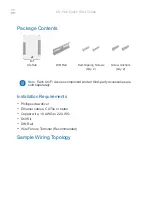Memory Controller
MPC561/MPC563 Reference Manual, Rev. 1.2
Freescale Semiconductor
10-11
address type match the values programmed in the BR and OR for one of the memory controller banks, the
attributes for the memory cycle are taken from the OR and BR registers. These attributes include the
following fields: CSNT, ACS, SCY, BSCY, WP, TRLX, BI, PS, and SETA.
summarizes the
chip-select timing options.
Byte write and read-enable signals (WE/BE[0:3]) are available for each byte that is written to or read from
memory. An output enable (OE) signal is provided to eliminate external glue logic for read cycles. Upon
system reset, a global (boot) chip select is available. (Refer to
Section 10.7, “Global (Boot) Chip-Select
” for more information on the global chip select.) This provides a boot ROM chip select before
the system is fully configured.
NOTE
When a bank is configured for TA to be generated externally (SETA bit is
set) and the TRLX is set, the memory controller requires the external device
to provide at least one wait state before asserting TA to complete the
transfer. In this case, the minimum transfer time is three clock cycles.
The internal TA generation mode is enabled if the SETA bit in the OR register is cleared. However, if the
TA signal is asserted externally at least two clock cycles before the wait states counter has expired, this
assertion terminates the memory cycle. When SETA is cleared, it is forbidden to assert external TA less
than two clocks before the wait states counter expires.
Table 10-2. Timing Attributes Summary
Timing Attribute
Bits/Fields
Description
Access speed
TRLX
The TRLX (timing relaxed) bit determines strobe timing to be fast or
relaxed.
Intercycle space time
EHTR
The EHTR (extended hold time on read accesses) bit is provided for
devices that have long disconnect times from the data bus on read
accesses. EHTR specifies whether the next cycle is delayed one clock
cycle following a read cycle, to avoid data bus contentions. EHTR
applies to all cycles following a read cycle except for another read cycle
to the same region.
Synchronous or
asynchronous device
ACS, CSNT
The ACS (address-to-chip-select setup) and CSNT (chip-select
negation time) bits cause the timing of the strobes to be the same as the
address bus timing, or cause the strobes to have setup and hold times
relative to the address bus.
Wait states
SCY, BSCY,
SETA, TRLX
From zero to 15 wait states can be programmed for any cycle that the
memory controller generates. The transfer is then terminated internally.
In simplest case, the cycle length equals (2 + SCY) clock cycles, where
SCY represents the programmed number of wait states (cycle length in
clocks). The number of wait states is doubled if the TRLX bit is set (2 +
(SCY x 2)).
When the SETA (external transfer acknowledge) bit is set, TA must be
generated externally, so that external hardware determines the number
of wait states.
Summary of Contents for MPC561
Page 84: ...MPC561 MPC563 Reference Manual Rev 1 2 lxxxiv Freescale Semiconductor...
Page 144: ...Signal Descriptions MPC561 MPC563 Reference Manual Rev 1 2 2 46 Freescale Semiconductor...
Page 206: ...Central Processing Unit MPC561 MPC563 Reference Manual Rev 1 2 3 62 Freescale Semiconductor...
Page 302: ...Reset MPC561 MPC563 Reference Manual Rev 1 2 7 14 Freescale Semiconductor...
Page 854: ...Time Processor Unit 3 MPC561 MPC563 Reference Manual Rev 1 2 19 24 Freescale Semiconductor...
Page 968: ...Development Support MPC561 MPC563 Reference Manual Rev 1 2 23 54 Freescale Semiconductor...
Page 1144: ...Internal Memory Map MPC561 MPC563 Reference Manual Rev 1 2 B 34 Freescale Semiconductor...
Page 1212: ...TPU3 ROM Functions MPC561 MPC563 Reference Manual Rev 1 2 D 60 Freescale Semiconductor...
Page 1216: ...Memory Access Timing MPC561 MPC563 Reference Manual Rev 1 2 E 4 Freescale Semiconductor...


















